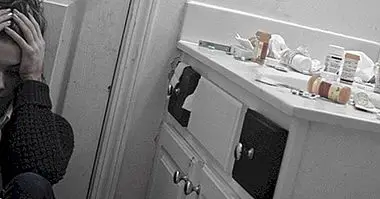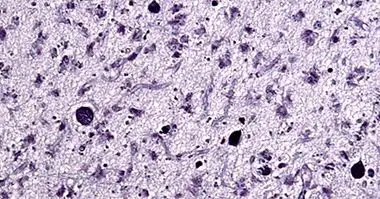Diogenes Syndrome: causes, symptoms and treatment
A lost screw, a shirt that no longer suits us, a wooden plank ...
Many people sometimes keep objects and things that, although at that moment we know we will not use them, for one reason or another (either because it brings back memories or because we believe that in the future they may be necessary) we decided to save and keep .
It is normal and in principle does not pose any problem in our lives. But in people with Diogenes syndrome this phenomenon becomes a habitual and problematic trend product of self-abandonment, going on to accumulate a large amount of objects and waste without any use and causing a great personal and social deterioration in their lives.
Diogenes syndrome: basic characteristics
Diogenes syndrome is a disorder characterized by those who suffer from it they collect and keep a large amount of belongings and possessions, usually waste, in their home . They have a great inability to get rid of them, so they accumulate more and more.
The objects kept by the individuals with this disorder can be very diverse, from objects of great value to waste and remains, not being the real or symbolic value of the object what produces its conservation. As in the accumulation disorder The person with Diogenes syndrome has great difficulty in disposing of their possessions, needing to keep them with them and experiencing anxiety and discomfort at the idea of losing them. If asked about the reason for this conservation, people with Diogenes syndrome do not usually know how to explain it.
Some authors propose that the Diogenes syndrome usually occurs in three phases . At first I would highlight the attitude of self-abandonment, starting to generate waste that is not eliminated and begins to accumulate. Subsequently and according to the number of waste is increasing, the individual goes to a second phase in which the profusion of garbage and waste makes it necessary to start organizing (not necessarily ordering) the material and space available, while it becomes worse the deterioration of habits. In a third and final phase the individual not only does not get rid of his waste, but he begins to collect elements from the outside in an active way.
Deriving from lack of hygiene and self-abandonment
In the long run, the cumulative behavior of these people causes the collected objects to occupy a large part of the individual's home, organizing themselves in a disorderly and expansive way throughout the whole house. This problem leads to the point that the functionality of the home is limited , access to certain areas such as the bed or kitchen is not possible. In addition, the disorder and lack of cleanliness caused by the accumulation cause serious hygiene problems that can compromise the health of the individual.
This syndrome produces a high level of deterioration in multiple areas, especially at the social level problems of coexistence . Those who suffer little by little are being secluded from the world, isolating themselves and minimizing contact with others, owing to both an increase in interpersonal conflicts due to their status as well as time spent storing and accumulating things. They also begin to abandon some of the main hygiene habits, both at home and at home.
These cases are often detected in advanced stages , due to complaints from neighbors and relatives because of the unhealthiness of the home of the affected, the smell and insects and rodents attracted by the objects.
It is also common that those who suffer from Diogenes syndrome end up having serious feeding problems , presenting altered eating patterns and eating little, badly and untimely. They can consume food in poor condition (derived from the lack of hygiene in the home or an indifference to its expiration). This together with the health problems derived from poor hygiene and the avoidance of contact with others can weaken them to the point of having to be hospitalized , and even that a high percentage of them die within a few years of the onset of the syndrome ..
Possible causes
Although the cause of cumulative behavior in cases of Diogenes syndrome is not fixed or fully known, The majority of those who suffer from it are people over 65 years of age, retired and often widows .
Thus, one of the most common characteristics is the presence of loneliness already before the accumulation starts. Whether due to the death of the couple or abandonment, this loneliness can lead to the progressive disappearance of concern for hygiene, food and contact with others, and behavioral and affective rigidity that promotes the perseveration of accumulation.They feel a great insecurity and a medium that they provide through accumulation. There is usually a stressful event that triggers the onset of symptoms.
A large part of the subjects with Diogenes syndrome they also present a mental or medical disorder prior , being very frequent that they are immersed in addiction processes to substances, dementias or in major depressions, often with psychotic characteristics. There is then a probable deterioration at the cognitive level which causes the person to stop worrying about healthiness and maintaining the state of health, food and hygiene.
Treatment of Diogenes syndrome
Diogenes syndrome is a complex disorder that requires treatment from different approaches . People with this disorder do not usually go to therapy voluntarily, being referred for medical or judicial services or pressured by their families.
The multidisciplinary intervention is because it is necessary to act on both the ideas and beliefs of the individual and their habits, since the accumulation of garbage becomes part of the person's day to day and it is difficult to break that dynamic. This is precisely why we must also act on the place where we live: focusing attention only on the person does not work.
In many cases, the authorities, alerted by complaints from neighbors and acquaintances, go to the home of these individuals and ends up cleaning and disinfecting the place. While this can temporarily end accumulated garbage , it does not solve the problem that the subject suffers nor does it help him to deal with situations in another way, so that if the external action ends there the subject will relapse again.
Evaluation and intervention
At the treatment level, it is a priority to evaluate the health status of the subject and correct the complications derived from the lack of food and hygiene . In cases in which this syndrome is produced or is aggravated by other disorders such as depression or a psychotic disorder, it will be necessary to apply the most appropriate strategies to treat the disorder itself, both psychologically and pharmacologically. The use of antidepressants such as SSRIs is frequent to improve mood.
Regarding psychological treatment It would be necessary to first see the existence of a problem and the need to solve it, given that the majority of those affected ignore or do not recognize their condition. It is also essential to perform a training in the skills and patterns of hygienic and nutritional behavior.
Given that in a great majority of cases there is a high level of insecurity this aspect has to be worked in therapy, as well as the existential passivity of which most of these patients show. It also becomes necessary to re-establish the person's contact with the world, through training in social skills and participation in community activities . This helps to combat the loneliness and anxiety that this causes. The detachment of objects and waste must also be worked on and what the patient thinks about conservation.
As in the vast majority of mental disorders Social and family support is an essential factor for the recovery and / or improvement of the quality of life. The psychoeducation of the closest environment is necessary in order to understand the state of the patient and its monitoring, it is important to monitor their patterns of activity and not return to a state of isolation.
Difference with accumulation disorder
The characteristics of Diogenes syndrome resemble to a great extent another disorder with which it is frequently confused, the so-called accumulation disorder or hoarding .
Both problems have in common the accumulation of a large number of objects and possessions that have a hard time getting rid of by those who suffer them, together with the fact that this accumulation produces serious problems in the use of personal domestic space. In both cases anosognosia may occur, or even a delusional idea according to which the accumulation is not harmful despite evidence to the contrary (although it is much more common the absence of recognition of the existence of a disorder in the Diogenes syndrome).
In addition, problems in various vital domains usually appear in both disorders, especially in regard to interpersonal relationships, in many cases shying away from close contact with people.
However, in the case of accumulation disorder or hoarding the accumulation is totally intentional and usually has a concrete reason to want to keep it . It is a disorder linked to obsessive characteristics.
In the case of the Diogenes syndrome, accumulation is usually due to a process of deterioration, and it is common that there is an insane process in progress, and the accumulation is usually due to unintentional passive elements (although in many cases they also collect and accumulate waste as a mechanism of emotional protection).
In addition, while the deterioration of personal hygiene habits and diet is largely present in the Diogenes syndrome, these characteristics do not usually occur in accumulation disorder, being its relatively usual behavior outside of the respective to the collection .
Bibliographic references:
- American Psychiatric Association. (2013). Diagnostic and Statistical Manual of Mental Disorders. Fifth edition. DSM-V. Masson, Barcelona.
- Gómez, I., Prieto, F. (2008). Clinical forms of Diogenes syndrome. About three cases. [Electronic version]. Biological Psychiatry, 15 (3), 97-9.
- Marcos, M. & Gómez-Pellín, M.C. (2008). A tale of a misnamed eponym: Diogenes syndrome. International Journal of Geriatric Psychiatry, vol. 23, 9.
- Saiz, D., Lozano Garcia, M., Burguillo, F., Botillo, C. (2003). The Diogenes syndrome: about two cases. [Electronic version]. Psychiatry. com, 7 (5).



















